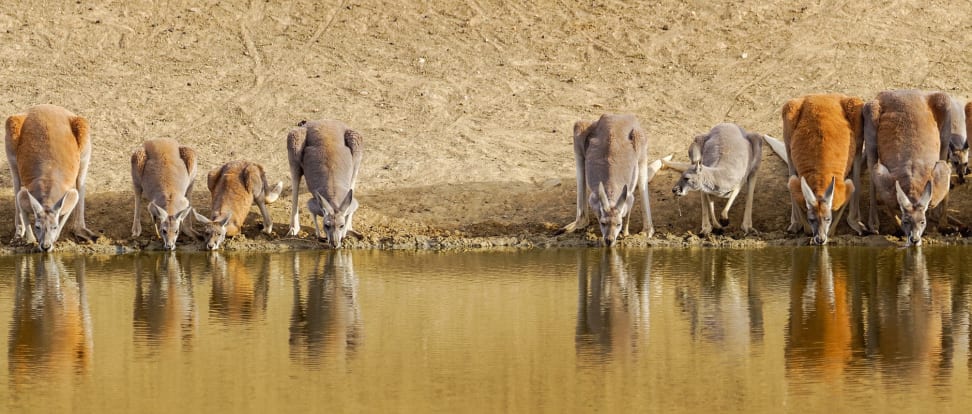How Kangaroos Could Help Save the World
Problem: climate change. Solution: kangaroos?
 Credit:
Credit:
Products are chosen independently by our editors. Purchases made through our links may earn us a commission.
There's a popular origin story that goes something like this: When Captain James Cook first landed in Australia, he pointed at a nearby animal and asked a native what it was. The Aboriginal replied, "Gangurru."
Translation: "I don't understand you."
Unfortunately, the story isn't true. But what is true is that kangaroos have unusually eco-friendly farts. (Yes, you read that correctly.) And that little factoid could help save the world for us human beings.
Okay, let's backtrack a little and talk about methane. This common molecule is the second most prevalent greenhouse gas produced in the United States, and according to the EPA, it has an environmental impact 20 times greater than carbon dioxide. That's because it lasts longer in the atmosphere and thus traps more heat.
![Cows are ruminants, meaning that they break down their food by fermentation. [Credit: Flickr user "bhampton1963" (CC BY-NC 2.0)]](https://reviewed-com-res.cloudinary.com/image/fetch/s--53ncmYNN--/b_white,c_limit,cs_srgb,f_auto,fl_progressive.strip_profile,g_center,q_auto,w_792/https://reviewed-production.s3.amazonaws.com/attachment/77c22ba077804f06/Cow-eating.jpg)
Cows are ruminants, meaning that they break down their food by fermentation. [Credit: Flickr user "bhampton1963" (CC BY-NC 2.0)]
The majority of the methane in Earth's atmosphere comes from livestock. A single cow can produce 53 to 132 gallons of methane a day just by belching. And as the world's population grows, so will the number of cows belching methane into the air.
All of this noxious gas comes from the way livestock digest their food. Most livestock fall under the category of "ruminants," a group of animals defined by their multiple stomachs. One of these is called a rumen, and that's where animals like cows digest food through fermentation. The byproduct? You guessed it: methane.
![Kangaroos eat grass, just like cows. [Credit: Flickr user "Tambako The Jaguar" (CC BY-NC-ND 2.0)]](https://reviewed-com-res.cloudinary.com/image/fetch/s--DagsmR6N--/b_white,c_limit,cs_srgb,f_auto,fl_progressive.strip_profile,g_center,q_auto,w_792/https://reviewed-production.s3.amazonaws.com/attachment/923240d6d78b4060/Kangaroo.jpg)
Kangaroos eat grass, just like cows. [Credit: Flickr user "Tambako The Jaguar" (CC BY-NC-ND 2.0)]
Here's where the humble kangaroo comes in. Ever since researchers identified kangaroos' unusually "green" farts, they've dreamed of transferring that trait to more popular food animals. See, marsupials are also ruminants, but the majority of the byproducts of their digestion are broken down by specialized bacteria into acetate, which the kangaroo converts into energy.
The project was dealt a blow back in 2012, when researchers at a zoo in Copenhagen proved that marsupials do in fact produce methane. Still, they found that it was only one-quarter to one-third the amount produced by a cow fed on the same diet.
These days, professor Athol Klieve of the University of Queensland in Australia is pushing forward in studying the secrets of the kangaroo's relatively flatulence-free lifestyle.
Dr. Klieve believes that if we can figure out how to transfer the microbes responsible—in this case, several species of reductive acetogen bacteria—into cattle, we could put a huge dent in the amount of methane produced worldwide.
“We can hopefully identify how to improve the ability of reductive acetogens to out-compete the methanogens in cattle, reduce greenhouse gas emissions, and also increase feed conversion efficiency," Klieve said.
Via: University of Queensland Australia Hero Image: Flickr user "kookr" (CC BY-NC 2.0)
